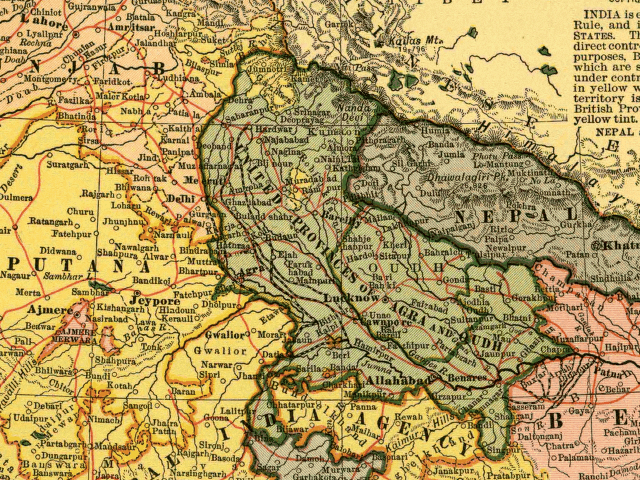- United Provinces of Agra and Oudh
Infobox Former Subdivision
native_name =
conventional_long_name = United Provinces of Agra and Oudh
common_name = United Provinces
nation = British India
status_text = British colony
era = New Imperialism
year_start = 1902
date_start =
event_start=
year_end = 1947
date_end =
event_end=
event1 =
date_event1 =
p1 =
s1 =
flag_p1 =
flag_s1 =
image_map_caption = Map of the United Provinces, 1903
stat_area1 =
stat_year1 =
stat_pop1 =
footnotes = The United Provinces of Agra and Oudh, more commonly the United Provinces, was aprovince ofBritish India , which existed from 1902 to 1947. It corresponded approximately to the combined regions of the present-dayIndia n states ofUttar Pradesh andUttarakhand . From 1856 to 1902, the region was known as theNorth-Western Provinces and Oudh.History
By the 18th century, the once vast
Mughal Empire was collapsing, undone by internal dissension and by expansion of theMaratha s from theDeccan , the British fromBengal , and the Afghans fromAfghanistan . By the middle of the century, present-day Uttar Pradesh was divided between several states:Awadh (Oudh) in the centre and east, ruled by aNawab who owed allegiance to the Mughal Emperor, but was "de facto" independent;Rohilkhand in the north, ruled by Afghans; the Marathas, who controlled theBundelkhand region in the south, and the Mughal Empire, which controlled the entireDoab (the strip of land between theGanges andYamuna rivers) and theDelhi region.In 1765, the combined forces of Awadh and the Mughal Emperor met the British at the
Battle of Buxar . The British won, but they did not take any territory; the whole of Awadh was restored to the Nawab, and the Mughal emperorShah Alam was restored the subas ofAllahabad and Kora in the lower Doab, with a British garrison in the fort of Allahabad. Governor-GeneralWarren Hastings later augmented the territory of Awadh by lending the nawab a British army to conquerRohilkhand in theRohilla War , and by giving Allahabad and Kora to Awadh on the ground that Shah Alam had placed himself in the power of the Marathas. At the same time the British received the province ofBenares from Awadh.Subsequently no great change took place until the arrival of Lord Wellesley (Governor-General 1797-1805) who acquired a very large accession of territory in two instalments. In 1801 he obtained from the
Nawab of Oudh the cession of Rohilkhand, the lower Doab, and theGorakhpur Division , thus enclosing Awadh on all sides except the north. In 1804, as the result of Lord Lake's victories in theSecond Anglo-Maratha War , part of Bundelkhand and the rest of the Doab, includingAgra and the guardianship of the old and blind emperor, Shah Alam, at Delhi, were obtained from Scindia. In 1815 theKumaon Division was acquired after theGurkha War , and a further portion of Bundelkhand from the MarathaPeshwa in 1817. These new acquisitions, known as the ceded and conquered provinces, continued to be administered by the governor-general as part ofBengal . In 1833 an act of Parliament was passed to constitute a new presidency (province), with its capital atAgra . But this scheme was never fully carried out, and in 1835 another statute authorized the appointment of a lieutenant-governor for the North-Western Provinces, as they were then known.The North-Western Provinces included the Delhi and
Gurgaon territories, transferred later, after theRevolt of 1857 to the Punjab; and also (after 1853) theSaugor and Nerbudda Territories , which in 1861 became part of theCentral Provinces . Awadh remained under its nawab, who was permitted to assume the title of king in 1819. Awadh was annexed in 1856 and constituted a separate chief commissionership. Then followed theRevolt of 1857 , when all signs of British rule were for a time swept away throughout the greater part of the two provinces. The lieutenant-governor died when shut up in the fort atAgra , and Oudh was only reconquered after several campaigns lasting for eighteen months.In 1877 the offices of lieutenant-governor of the North-Western Provinces and chief commissioner of Oudh were combined in the same person; and in 1902, when the new name of United Provinces of
Agra and Oudh was introduced, the title of chief commissioner was dropped, though Oudh still retained some marks of its former independence. In 1935, the name of the province was shortened to the United Provinces. The Raj province becameUttar Pradesh state afterIndia 's independence on January 26, 1950.Geography
The Provinces were bounded on the north by
Tibet , and on the north-east byNepal ; on the east and south-east by the Champaran, Saran, Shahabad, and PalamauDistricts of Bengal; on the south by two of the Chota Nagpur States in the Central Provinces, Rewah and some small States in the Central India Agency, and Saugor District in the Central Provinces; on the west by the States of Gwalior, Dholpur, and Bharatpur, the Districts of Gurgaon, Delhi, Karnal, and Ambala in the Punjab, and the Punjab States of Sirmur and Jubbal. The Jumna river formed part of the western boundary, the Ganges part of the southern, and the Gandak part of the eastern; other boundaries are artificial. According to the District surveys the areas of the two Provinces are, in square miles:Agra , 83,198; Oudh, 23,966; total, 107,164.Including some river-beds which form District boundaries and are excluded from the District details, the total area amounts to 107,494 square miles. The area of the two Native States in the Provinces (Rampur and Tehri) is 5,079 square miles more. A Presidency ofAgra was first formed in 1834, up to which date the area then separated had been included in the Presidency of Bengal,being sometimes called the Western Provinces. The United Provinces included four distinct tracts of country namely, portions of the Himalayas, the sub-Himalayan tracts, the great Gangetic plain, and portions of the hill systems of Central India. [ [http://dsal.uchicago.edu/reference/gazetteer/pager.html?objectid=DS405.1.I34_V24_139.gifUnited Provinces ofAgra and Oudh - United Provinces ofAgra and Oudh] ]References
*1911
Wikimedia Foundation. 2010.
